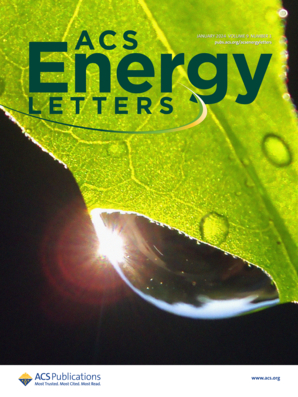Electroswitchable Noble-Metal-Free Catalysis for Molecular Solar Thermal Systems
IF 19.3
1区 材料科学
Q1 CHEMISTRY, PHYSICAL
引用次数: 0
Abstract
Molecular solar thermal (MOST) systems convert solar energy into chemical energy via a simple unimolecular reaction, enabling efficient energy storage. However, controlling the energy release remains a challenge. Here, we present an electroswitchable, noble-metal-free hybrid catalyst that enables energy release with high activity and selectivity. The MOST system is p-methoxyphenyl-ethyl ester-norbornadiene (mPENBD), which is photoconverted to its energy-rich quadricyclane isomer (mPEQC). A CoII porphyrin derivative, anchored as a self-assembled monolayer (SAM) on an atomically defined Co3O4(111) electrode, catalyzes the back-conversion of mPEQC to mPENBD with exceptional selectivity. Over 100 cycles, no side products were detected, and only minimal deactivation occurred. Most importantly, catalytic activity can be switched on and off via electrode potential due to the reversible conversion between an active CoII porphyrin SAM and an inactive CoI porphyrin SAM. This electroswitchable catalyst enables precise control of energy release in MOST-based solar energy storage systems.

分子太阳能热系统的电开关无贵金属催化
分子太阳能热(MOST)系统通过简单的单分子反应将太阳能转化为化学能,从而实现高效的能量存储。然而,控制能量释放仍然是一个挑战。在这里,我们提出了一种可电切换的,不含贵金属的杂化催化剂,它能以高活性和选择性释放能量。MOST体系是对甲氧基苯基乙酯-降冰片二烯(mPENBD),其光能转化为其富能量的四环异构体(mPEQC)。CoII卟啉衍生物作为自组装单层(SAM)锚定在原子定义的Co3O4(111)电极上,以优异的选择性催化mPEQC向mPENBD的反转化。超过100次循环,没有检测到副作用,只有最小的失活发生。最重要的是,由于活性CoII卟啉SAM和非活性CoI卟啉SAM之间的可逆转化,催化活性可以通过电极电位打开和关闭。这种电开关催化剂能够精确控制基于most的太阳能储能系统中的能量释放。
本文章由计算机程序翻译,如有差异,请以英文原文为准。
求助全文
约1分钟内获得全文
求助全文
来源期刊

ACS Energy Letters
Energy-Renewable Energy, Sustainability and the Environment
CiteScore
31.20
自引率
5.00%
发文量
469
审稿时长
1 months
期刊介绍:
ACS Energy Letters is a monthly journal that publishes papers reporting new scientific advances in energy research. The journal focuses on topics that are of interest to scientists working in the fundamental and applied sciences. Rapid publication is a central criterion for acceptance, and the journal is known for its quick publication times, with an average of 4-6 weeks from submission to web publication in As Soon As Publishable format.
ACS Energy Letters is ranked as the number one journal in the Web of Science Electrochemistry category. It also ranks within the top 10 journals for Physical Chemistry, Energy & Fuels, and Nanoscience & Nanotechnology.
The journal offers several types of articles, including Letters, Energy Express, Perspectives, Reviews, Editorials, Viewpoints and Energy Focus. Additionally, authors have the option to submit videos that summarize or support the information presented in a Perspective or Review article, which can be highlighted on the journal's website. ACS Energy Letters is abstracted and indexed in Chemical Abstracts Service/SciFinder, EBSCO-summon, PubMed, Web of Science, Scopus and Portico.
 求助内容:
求助内容: 应助结果提醒方式:
应助结果提醒方式:


